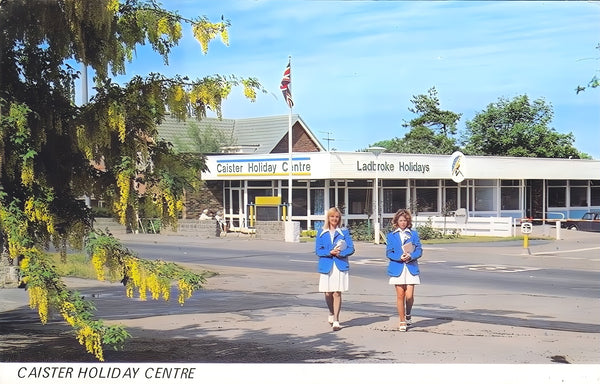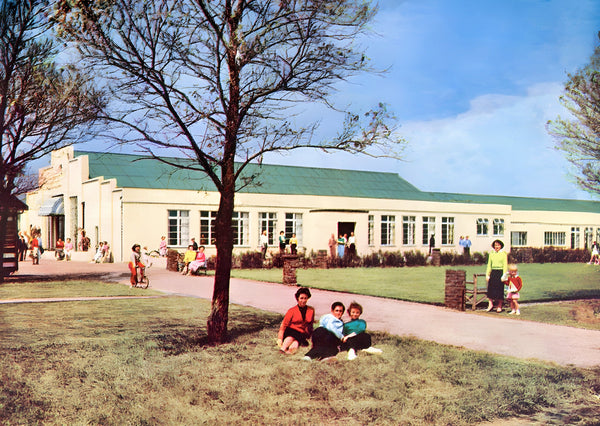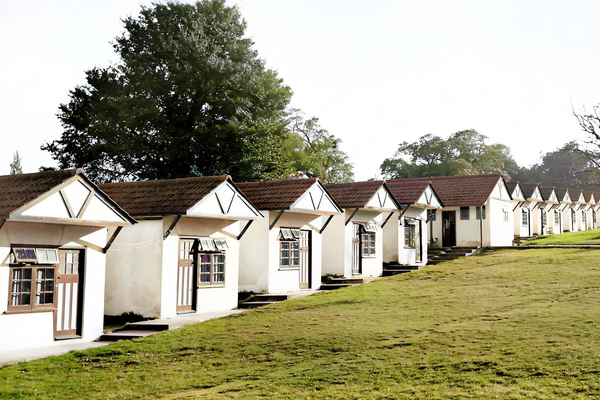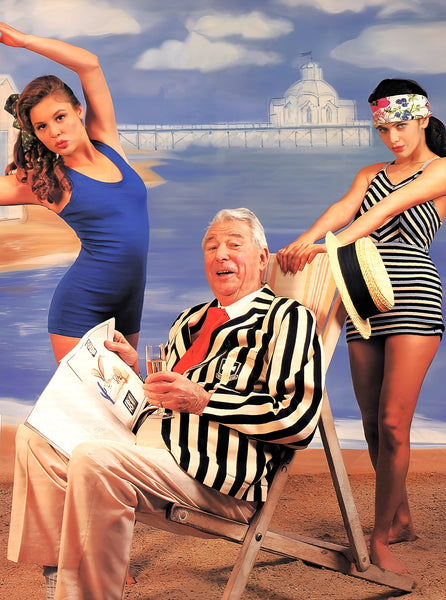Dating from the 1930s this camp was known as the Sunshine Holiday Camp and had a motley collection of converted buses, trams, old railway carriages and sheds. It was one of several such camps that dotted the coastline and a local newspaper said that “most had the general air of a mining camp where the strike is uncertain and nobody cares”.
In 1933 a new luxury £25,000 camp opened in Cayton Bay built by the NALGO Union as a way to provide cheap holidays for its members. They’d already built a popular camp down in Croyde Bay, Devon.

During the late-1930s a scheme was put forward to build a new bypass along the coast to relieve congestion. The council bought a 3-mile stretch of land wide enough to build a dual carriageway and part of this land sliced through the edge of the Sunshine camp. But then war intervened and the idea was forgotten….for 60 years.
In 1946, the Wallis family purchased the Sunshine camp for £40,000 and promptly began revitalizing the site. They began acquiring more land and renamed it simply as Wallis’s Cayton Bay. They cleared away the old shanty town and introduced modern touring caravan spaces, which could be rented for £15 per year. By the next year, they’d built 200 new chalets, and within two years, this number had grown to 450. Due to post-war shortages, these were mostly built “on the cheap” with whatever supplies were available. They were never intended to last long, but rather to satisfy the immediate demand of the time.

By 1950 the touring caravans had been mostly replaced with 200 static vans. All accommodation was available to rent “with or without full board”. By this time the camp was advertising 600 caravans and chalets. Facilities at the time included a dance hall, restaurant, fish & chip shop, cinema, bicycle rental and general store.
In June 1954 construction started on an impressive new entertainment pavilion capable of accommodating 1000 people. Designed by Scarborough architect Mr W Gray the £34,000 building featured a large stage, film projection room and a maplewood ballroom floor. The building later contained the popular Rendezvous Club, Mullarcy’s pub and the Bamboo Lounge. Construction was complete by December of that year.




During the early-1960s a batch of new “architect designed” brick chalets were built known as Bungalows. In 1964 a 68-room motel was built, said to be the first purpose-built resort motel in the country. Described as “similar to those in Miami” the apartments featured an all-electric kitchen, lounge, TV, dining room, sun deck and one or two bedrooms.

Dudley Wallis, the son of the founder, was now in charge and became a popular local figure. He would often bring celebrity visitors to the camp and in 1969 British actress Alexandra Bastedo made a personal appearance and signed autographs
During the 1970s the camp began demolishing the old post-war chalets and replacing them with static caravans, bringing the total number up to around 550. The full board option was abandoned with all units now being self-catering. In 1974 the nearby NALGO camp closed due to mounting losses. In the same year Wallis’s opened a new entertainment venue known as ‘Stage 3’.

The camp was sold to Ladbroke Holidays in 1981 for £1.89 million. They kept the old name and it continued to be known as Wallis’s Supercentre. The motel remained in use but the “motel” name was dropped and the apartments became known as Villas, which attracted a premium price.

In January 1988 Ladbrokes sold all their holiday parks to Mecca Leisure, owner of Warners Holiday Camps, for £55 million. The following year most of the camps were rebranded under the Warners name, who soon announced a major refurbishment of Cayton Bay.
In 1990 Mecca Leisure was acquired by Rank, owners of Butlins and Haven, so most of the parks were later rebranded yet again under the Haven name.
In 1993 the idea of building the bypass was resurrected by the council, much to the horror of local residents. It was discovered that the main pavilion building and motel had been built on land that the council had acquired back in the 1930s, and would need to be demolished. As they were both in need of costly renovations, Haven simply closed them down. The abandoned and derelict buildings became an eyesore for many years.

In 1998 actors Michael Caine, Jane Horrocks, Ewan McCgregor and Jim Broadbent visited Cayton Bay whilst filming the movie :little Voice’. The dreelict Rendezvous nightclub inside the old pavilion was refurbished and renamed “Mr Boo’s” for its starring role. The building was demolished the following year.

The council continued to push for the new bypass but faced fierce local opposition. Various concessions were made, including reducing it from a dual carriageway to a single lane in each direction. It finally opened in 2008, passing through the northern edge of the camp where caravans used to stand. A pedestrian subway was built connecting the camp to the beach. A new roundabout was constructed for camp access.

In 2000 Haven sold the camp to Park Resorts. In 2015 Park Resorts merged with Parkdean. The park is still open today and continues to be as popular as ever. Most of the old chalets/bungalows are gone and it’s mostly now all caravans, with a handful of luxury lodges.
What happened to Dudley Wallis?
In 1985 Dudley Wallis, along with his brother and sister, built a 6-acre children’s fun park in Scarborough known as Kinderland. Despite much local opposition the park soon gained a well-loved reputation. 73-year old Wallis put the site up for sale in 1999 as he was looking to retire but no takers were found. He died the following year and his family closed Kinderland and handed the lease back to the council. It was taken over by the Sykes family and finally closed for good in 2007. It was later demolished.



